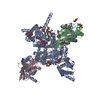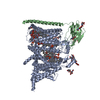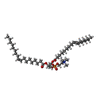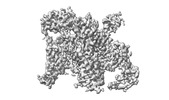+ Open data
Open data
- Basic information
Basic information
| Entry |  | |||||||||
|---|---|---|---|---|---|---|---|---|---|---|
| Title | Voltage-gated sodium channel Nav1.7 variant M2 | |||||||||
 Map data Map data | Cryo-EM map for Nav1.7-M2 | |||||||||
 Sample Sample |
| |||||||||
 Keywords Keywords | Voltage-gated sodium channel / MEMBRANE PROTEIN | |||||||||
| Function / homology |  Function and homology information Function and homology informationresponse to pyrethroid / corticospinal neuron axon guidance / positive regulation of voltage-gated sodium channel activity / action potential propagation / detection of mechanical stimulus involved in sensory perception / voltage-gated sodium channel activity involved in cardiac muscle cell action potential / regulation of atrial cardiac muscle cell membrane depolarization / membrane depolarization during Purkinje myocyte cell action potential / voltage-gated potassium channel activity involved in ventricular cardiac muscle cell action potential repolarization / cardiac conduction ...response to pyrethroid / corticospinal neuron axon guidance / positive regulation of voltage-gated sodium channel activity / action potential propagation / detection of mechanical stimulus involved in sensory perception / voltage-gated sodium channel activity involved in cardiac muscle cell action potential / regulation of atrial cardiac muscle cell membrane depolarization / membrane depolarization during Purkinje myocyte cell action potential / voltage-gated potassium channel activity involved in ventricular cardiac muscle cell action potential repolarization / cardiac conduction / membrane depolarization during cardiac muscle cell action potential / membrane depolarization during action potential / positive regulation of sodium ion transport / regulation of sodium ion transmembrane transport / axon initial segment / regulation of ventricular cardiac muscle cell membrane repolarization / cardiac muscle cell action potential involved in contraction / node of Ranvier / voltage-gated sodium channel complex / sodium channel inhibitor activity / locomotion / neuronal action potential propagation / Interaction between L1 and Ankyrins / voltage-gated sodium channel activity / detection of temperature stimulus involved in sensory perception of pain / Phase 0 - rapid depolarisation / behavioral response to pain / regulation of heart rate by cardiac conduction / intercalated disc / sodium channel regulator activity / membrane depolarization / neuronal action potential / cardiac muscle contraction / axon terminus / sensory perception of pain / T-tubule / sodium ion transmembrane transport / axon guidance / post-embryonic development / positive regulation of neuron projection development / circadian rhythm / response to toxic substance / Sensory perception of sweet, bitter, and umami (glutamate) taste / nervous system development / response to heat / perikaryon / gene expression / chemical synaptic transmission / transmembrane transporter binding / cell adhesion / inflammatory response / axon / synapse / extracellular region / plasma membrane Similarity search - Function | |||||||||
| Biological species |  Homo sapiens (human) Homo sapiens (human) | |||||||||
| Method | single particle reconstruction / cryo EM / Resolution: 3.37 Å | |||||||||
 Authors Authors | Yan N / Li Z / Wu Q / Huang G | |||||||||
| Funding support |  China, 1 items China, 1 items
| |||||||||
 Citation Citation |  Journal: Proc Natl Acad Sci U S A / Year: 2024 Journal: Proc Natl Acad Sci U S A / Year: 2024Title: Dissection of the structure-function relationship of Na channels. Authors: Zhangqiang Li / Qiurong Wu / Gaoxingyu Huang / Xueqin Jin / Jiaao Li / Xiaojing Pan / Nieng Yan /  Abstract: Voltage-gated sodium channels (Na) undergo conformational shifts in response to membrane potential changes, a mechanism known as the electromechanical coupling. To delineate the structure-function ...Voltage-gated sodium channels (Na) undergo conformational shifts in response to membrane potential changes, a mechanism known as the electromechanical coupling. To delineate the structure-function relationship of human Na channels, we have performed systematic structural analysis using human Na1.7 as a prototype. Guided by the structural differences between wild-type (WT) Na1.7 and an eleven mutation-containing variant, designated Na1.7-M11, we generated three additional intermediate mutants and solved their structures at overall resolutions of 2.9-3.4 Å. The mutant with nine-point mutations in the pore domain (PD), named Na1.7-M9, has a reduced cavity volume and a sealed gate, with all voltage-sensing domains (VSDs) remaining up. Structural comparison of WT and Na1.7-M9 pinpoints two residues that may be critical to the tightening of the PD. However, the variant containing these two mutations, Na1.7-M2, or even in combination with two additional mutations in the VSDs, named Na1.7-M4, failed to tighten the PD. Our structural analysis reveals a tendency of PD contraction correlated with the right shift of the static inactivation I-V curves. We predict that the channel in the resting state should have a "tight" PD with down VSDs. | |||||||||
| History |
|
- Structure visualization
Structure visualization
| Supplemental images |
|---|
- Downloads & links
Downloads & links
-EMDB archive
| Map data |  emd_38483.map.gz emd_38483.map.gz | 86 MB |  EMDB map data format EMDB map data format | |
|---|---|---|---|---|
| Header (meta data) |  emd-38483-v30.xml emd-38483-v30.xml emd-38483.xml emd-38483.xml | 18.6 KB 18.6 KB | Display Display |  EMDB header EMDB header |
| Images |  emd_38483.png emd_38483.png | 66.6 KB | ||
| Filedesc metadata |  emd-38483.cif.gz emd-38483.cif.gz | 7.3 KB | ||
| Others |  emd_38483_half_map_1.map.gz emd_38483_half_map_1.map.gz emd_38483_half_map_2.map.gz emd_38483_half_map_2.map.gz | 84.7 MB 84.7 MB | ||
| Archive directory |  http://ftp.pdbj.org/pub/emdb/structures/EMD-38483 http://ftp.pdbj.org/pub/emdb/structures/EMD-38483 ftp://ftp.pdbj.org/pub/emdb/structures/EMD-38483 ftp://ftp.pdbj.org/pub/emdb/structures/EMD-38483 | HTTPS FTP |
-Validation report
| Summary document |  emd_38483_validation.pdf.gz emd_38483_validation.pdf.gz | 951.8 KB | Display |  EMDB validaton report EMDB validaton report |
|---|---|---|---|---|
| Full document |  emd_38483_full_validation.pdf.gz emd_38483_full_validation.pdf.gz | 951.4 KB | Display | |
| Data in XML |  emd_38483_validation.xml.gz emd_38483_validation.xml.gz | 13.1 KB | Display | |
| Data in CIF |  emd_38483_validation.cif.gz emd_38483_validation.cif.gz | 15.5 KB | Display | |
| Arichive directory |  https://ftp.pdbj.org/pub/emdb/validation_reports/EMD-38483 https://ftp.pdbj.org/pub/emdb/validation_reports/EMD-38483 ftp://ftp.pdbj.org/pub/emdb/validation_reports/EMD-38483 ftp://ftp.pdbj.org/pub/emdb/validation_reports/EMD-38483 | HTTPS FTP |
-Related structure data
| Related structure data |  8xmnMC  8xmmC  8xmoC M: atomic model generated by this map C: citing same article ( |
|---|---|
| Similar structure data | Similarity search - Function & homology  F&H Search F&H Search |
- Links
Links
| EMDB pages |  EMDB (EBI/PDBe) / EMDB (EBI/PDBe) /  EMDataResource EMDataResource |
|---|---|
| Related items in Molecule of the Month |
- Map
Map
| File |  Download / File: emd_38483.map.gz / Format: CCP4 / Size: 91.1 MB / Type: IMAGE STORED AS FLOATING POINT NUMBER (4 BYTES) Download / File: emd_38483.map.gz / Format: CCP4 / Size: 91.1 MB / Type: IMAGE STORED AS FLOATING POINT NUMBER (4 BYTES) | ||||||||||||||||||||||||||||||||||||
|---|---|---|---|---|---|---|---|---|---|---|---|---|---|---|---|---|---|---|---|---|---|---|---|---|---|---|---|---|---|---|---|---|---|---|---|---|---|
| Annotation | Cryo-EM map for Nav1.7-M2 | ||||||||||||||||||||||||||||||||||||
| Projections & slices | Image control
Images are generated by Spider. | ||||||||||||||||||||||||||||||||||||
| Voxel size | X=Y=Z: 0.8374 Å | ||||||||||||||||||||||||||||||||||||
| Density |
| ||||||||||||||||||||||||||||||||||||
| Symmetry | Space group: 1 | ||||||||||||||||||||||||||||||||||||
| Details | EMDB XML:
|
-Supplemental data
-Half map: #2
| File | emd_38483_half_map_1.map | ||||||||||||
|---|---|---|---|---|---|---|---|---|---|---|---|---|---|
| Projections & Slices |
| ||||||||||||
| Density Histograms |
-Half map: #1
| File | emd_38483_half_map_2.map | ||||||||||||
|---|---|---|---|---|---|---|---|---|---|---|---|---|---|
| Projections & Slices |
| ||||||||||||
| Density Histograms |
- Sample components
Sample components
-Entire : Voltage-gated sodium channel Nav1.7-M2
| Entire | Name: Voltage-gated sodium channel Nav1.7-M2 |
|---|---|
| Components |
|
-Supramolecule #1: Voltage-gated sodium channel Nav1.7-M2
| Supramolecule | Name: Voltage-gated sodium channel Nav1.7-M2 / type: complex / ID: 1 / Parent: 0 / Macromolecule list: #1-#3 |
|---|---|
| Source (natural) | Organism:  Homo sapiens (human) Homo sapiens (human) |
-Macromolecule #1: Sodium channel protein type 9 subunit alpha
| Macromolecule | Name: Sodium channel protein type 9 subunit alpha / type: protein_or_peptide / ID: 1 / Number of copies: 1 / Enantiomer: LEVO |
|---|---|
| Source (natural) | Organism:  Homo sapiens (human) Homo sapiens (human) |
| Molecular weight | Theoretical: 231.291953 KDa |
| Recombinant expression | Organism:  Homo sapiens (human) Homo sapiens (human) |
| Sequence | String: MASWSHPQFE KGGGARGGSG GGSWSHPQFE KGFDYKDDDD KGTMAMLPPP GPQSFVHFTK QSLALIEQRI AERKSKEPKE EKKDDDEEA PKPSSDLEAG KQLPFIYGDI PPGMVSEPLE DLDPYYADKK TFIVLNKGKT IFRFNATPAL YMLSPFSPLR R ISIKILVH ...String: MASWSHPQFE KGGGARGGSG GGSWSHPQFE KGFDYKDDDD KGTMAMLPPP GPQSFVHFTK QSLALIEQRI AERKSKEPKE EKKDDDEEA PKPSSDLEAG KQLPFIYGDI PPGMVSEPLE DLDPYYADKK TFIVLNKGKT IFRFNATPAL YMLSPFSPLR R ISIKILVH SLFSMLIMCT ILTNCIFMTM NNPPDWTKNV EYTFTGIYTF ESLVKILARG FCVGEFTFLR DPWNWLDFVV IV FAYLTEF VNLGNVSALR TFRVLRALKT ISVIPGLKTI VGALIQSVKK LSDVMILTVF CLSVFALIGL QLFMGNLKHK CFR NSLENN ETLESIMNTL ESEEDFRKYF YYLEGSKDAL LCGFSTDSGQ CPEGYTCVKI GRNPDYGYTS FDTFSWAFLA LFRL MTQDY WENLYQQTLR AAGKTYMIFF VVVIFLGSFY LINLILAVVA MAYEEQNQAN IEEAKQKELE FQQMLDRLKK EQEEA EAIA AAAAEYTSIR RSRIMGLSES SSETSKLSSK SAKERRNRRK KKNQKKLSSG EEKGDAEKLS KSESEDSIRR KSFHLG VEG HRRAHEKRLS TPNQSPLSIR GSLFSARRSS RTSLFSFKGR GRDIGSETEF ADDEHSIFGD NESRRGSLFV PHRPQER RS SNISQASRSP PMLPVNGKMH SAVDCNGVVS LVDGRSALML PNGQLLPEVI IDKATSDDSG TTNQIHKKRR CSSYLLSE D MLNDPNLRQR AMSRASILTN TVEELEESRQ KCPPWWYRFA HKFLIWNCSP YWIKFKKCIY FIVMDPFVDL AITICIVLN TLFMAMEHHP MTEEFKNVLA IGNLVFTGIF AAEMVLKLIA MDPYEYFQVG WNIFDSLIVT LSLVELFLAD VEGLSVLRSF RLLRVFKLA KSWPTLNMLI KIIGNSVGAF GNLTLVLAII VFIFAVVGMQ LFGKSYKECV CKINDDCTLP RWHMNDFFHS F LIVFRVLC GEWIETMWDC MEVAGQAMCL IVYMMVMVIG NLVVLNLFLA LLLSSFSSDN LTAIEEDPDA NNLQIAVTRI KK GINYVKQ TLREFILKAF SKKPKISREI RQAEDLNTKK ENYISNHTLA EMSKGHNFLK EKDKISGFGS SVDKHLMEDS DGQ SFIHNP SLTVTVPIAP GESDLENMNA EELSSDSDSE YSKVRLNRSS SSECSTVDNP LPGEGEEAEA EPMNSDEPEA CFTD GCVWR FSCCQVNIES GKGKIWWNIR KTCYKIVEHS WFESFIVLMI LLSSGALAFE DIYIERKKTI KIILEYADKI FTYIF ILEM LLKWIAYGYK TYFTNAWCWL DFLIVDVSLV TLVANTLGYS DLGPIKSLRT LRALRPLRAL SRFEGMRVVV NALIGA IPS IMNVLLVCLI FWLIFSIMGV NLFAGKFYEC INTTDGSRFP ASQVPNRSEC FALMNVSQNV RWKNLKVNFD NVGLGYL SL LQVATFKGWT IIMYAAVDSV NVDKQPKYEY SLYMYIYFVV FIIFGSFFTL NLFICVIIDN FNQQKKKLGG QDIFMTEE Q KKYYNAMKKL GSKKPQKPIP RPGNKIQGCI FDLVTNQAFD ISIMVLICLN MVTMMVEKEG QSQHMTEVLY WINVVFIIL FTGECVLKLI SLRHYYFTVG WNIFDFVVVI ISIVGMFLAD LIETYFVSPT LFRVIRLARI GRILRLVKGA KGIRTLLFAL MMSLPALFN IGLLLFLVMF IYAIFGMSNF AYVKKEDGIN DMFNFETFGN SMICLFQITT SAGWDGLLAP ILNSKPPDCD P KKVHPGSS VEGDCGNPSV GIFYFVSYII ISFLVVVNMY IAVILENFSV ATEESTEPLS EDDFEMFYEV WEKFDPDATQ FI EFSKLSD FAAALDPPLL IAKPNKVQLI AMDLPMVSGD RIHCLDILFA FTKRVLGESG EMDSLRSQME ERFMSANPSK VSY EPITTT LKRKQEDVSA TVIQRAYRRY RLRQNVKNIS SIYIKDGDRD DDLLNKKDMA FDNVNENSSP EKTDATSSTT SPPS YDSVT KPDKEKYEQD RTEKEDKGKD SKESKK UniProtKB: Sodium channel protein type 9 subunit alpha |
-Macromolecule #2: Sodium channel subunit beta-1
| Macromolecule | Name: Sodium channel subunit beta-1 / type: protein_or_peptide / ID: 2 / Number of copies: 1 / Enantiomer: LEVO |
|---|---|
| Source (natural) | Organism:  Homo sapiens (human) Homo sapiens (human) |
| Molecular weight | Theoretical: 26.355857 KDa |
| Recombinant expression | Organism:  Homo sapiens (human) Homo sapiens (human) |
| Sequence | String: MGRLLALVVG AALVSSACGG CVEVDSETEA VYGMTFKILC ISCKRRSETN AETFTEWTFR QKGTEEFVKI LRYENEVLQL EEDERFEGR VVWNGSRGTK DLQDLSIFIT NVTYNHSGDY ECHVYRLLFF ENYEHNTSVV KKIHIEVVDK ANRDMASIVS E IMMYVLIV ...String: MGRLLALVVG AALVSSACGG CVEVDSETEA VYGMTFKILC ISCKRRSETN AETFTEWTFR QKGTEEFVKI LRYENEVLQL EEDERFEGR VVWNGSRGTK DLQDLSIFIT NVTYNHSGDY ECHVYRLLFF ENYEHNTSVV KKIHIEVVDK ANRDMASIVS E IMMYVLIV VLTIWLVAEM IYCYKKIAAA TETAAQENAS EYLAITSESK ENCTGVQVAE LEHHHHHHHH HH UniProtKB: Sodium channel regulatory subunit beta-1 |
-Macromolecule #3: Sodium channel subunit beta-2
| Macromolecule | Name: Sodium channel subunit beta-2 / type: protein_or_peptide / ID: 3 / Number of copies: 1 / Enantiomer: LEVO |
|---|---|
| Source (natural) | Organism:  Homo sapiens (human) Homo sapiens (human) |
| Molecular weight | Theoretical: 25.9796 KDa |
| Recombinant expression | Organism:  Homo sapiens (human) Homo sapiens (human) |
| Sequence | String: MHRDAWLPRP AFSLTGLSLF FSLVPPGRSM EVTVPATLNV LNGSDARLPC TFNSCYTVNH KQFSLNWTYQ ECNNCSEEMF LQFRMKIIN LKLERFQDRV EFSGNPSKYD VSVMLRNVQP EDEGIYNCYI MNPPDRHRGH GKIHLQVLME EPPERDSTVA V IVGASVGG ...String: MHRDAWLPRP AFSLTGLSLF FSLVPPGRSM EVTVPATLNV LNGSDARLPC TFNSCYTVNH KQFSLNWTYQ ECNNCSEEMF LQFRMKIIN LKLERFQDRV EFSGNPSKYD VSVMLRNVQP EDEGIYNCYI MNPPDRHRGH GKIHLQVLME EPPERDSTVA V IVGASVGG FLAVVILVLM VVKCVRRKKE QKLSTDDLKT EEEGKTDGEG NPDDGAKLEH HHHHHHHHH UniProtKB: Sodium channel regulatory subunit beta-2 |
-Macromolecule #5: 2-acetamido-2-deoxy-beta-D-glucopyranose
| Macromolecule | Name: 2-acetamido-2-deoxy-beta-D-glucopyranose / type: ligand / ID: 5 / Number of copies: 6 / Formula: NAG |
|---|---|
| Molecular weight | Theoretical: 221.208 Da |
| Chemical component information |  ChemComp-NAG: |
-Macromolecule #6: 1-O-OCTADECYL-SN-GLYCERO-3-PHOSPHOCHOLINE
| Macromolecule | Name: 1-O-OCTADECYL-SN-GLYCERO-3-PHOSPHOCHOLINE / type: ligand / ID: 6 / Number of copies: 5 / Formula: LPE |
|---|---|
| Molecular weight | Theoretical: 510.708 Da |
| Chemical component information |  ChemComp-LPE: |
-Macromolecule #7: 1,2-DIOLEOYL-SN-GLYCERO-3-PHOSPHOCHOLINE
| Macromolecule | Name: 1,2-DIOLEOYL-SN-GLYCERO-3-PHOSPHOCHOLINE / type: ligand / ID: 7 / Number of copies: 3 / Formula: PCW |
|---|---|
| Molecular weight | Theoretical: 787.121 Da |
| Chemical component information |  ChemComp-PCW: |
-Experimental details
-Structure determination
| Method | cryo EM |
|---|---|
 Processing Processing | single particle reconstruction |
| Aggregation state | particle |
- Sample preparation
Sample preparation
| Buffer | pH: 7.5 |
|---|---|
| Vitrification | Cryogen name: ETHANE |
- Electron microscopy
Electron microscopy
| Microscope | FEI TITAN KRIOS |
|---|---|
| Image recording | Film or detector model: GATAN K3 (6k x 4k) / Average electron dose: 50.0 e/Å2 |
| Electron beam | Acceleration voltage: 300 kV / Electron source:  FIELD EMISSION GUN FIELD EMISSION GUN |
| Electron optics | Illumination mode: FLOOD BEAM / Imaging mode: BRIGHT FIELD / Nominal defocus max: 1.8 µm / Nominal defocus min: 1.5 µm |
| Experimental equipment |  Model: Titan Krios / Image courtesy: FEI Company |
- Image processing
Image processing
| Startup model | Type of model: NONE |
|---|---|
| Final reconstruction | Resolution.type: BY AUTHOR / Resolution: 3.37 Å / Resolution method: FSC 0.143 CUT-OFF / Number images used: 77511 |
| Initial angle assignment | Type: MAXIMUM LIKELIHOOD |
| Final angle assignment | Type: MAXIMUM LIKELIHOOD |
 Movie
Movie Controller
Controller











 Z (Sec.)
Z (Sec.) Y (Row.)
Y (Row.) X (Col.)
X (Col.)




































